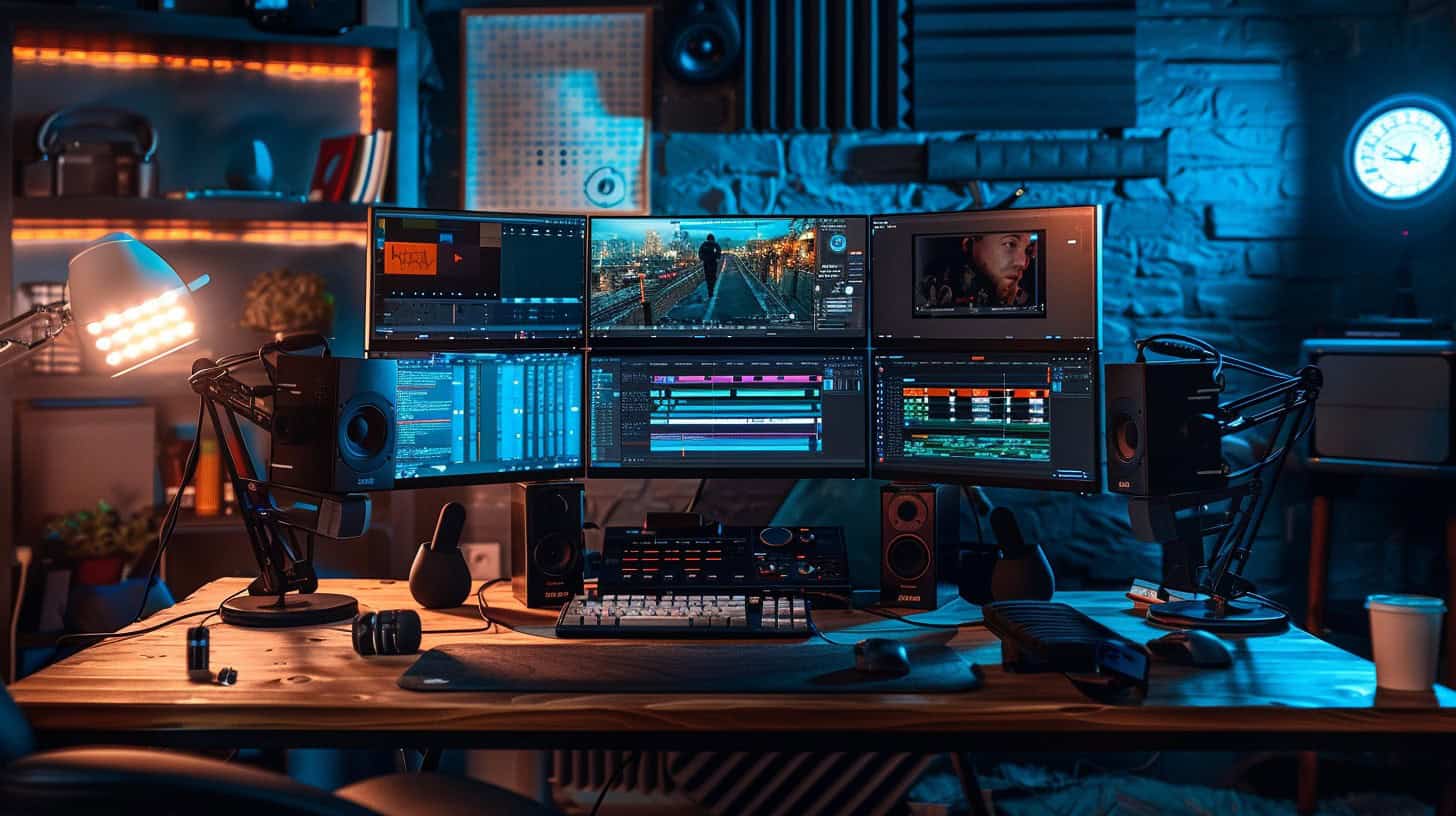Dreaming of turning your gaming passion into a full-time job? Good news: many are already living that dream, thanks to platforms like Twitch. This article will guide you through six crucial steps to make it big in the streaming world.
Ready? Let’s begin!
Key Takeaways
Streamers make money through ads, sponsorships, and donations. Partnering with platforms like Twitch can earn you between $3,000 to $5,000 a month if you stream for 40+ hours weekly.
Building a strong community is key for success in streaming. Engage with viewers by chatting during streams and sharing content on social media platforms.
To start streaming, you need good equipment, including a computer that can handle live-streaming services, a decent webcam, microphone, and reliable internet service.
Consistent scheduling helps grow your audience. Stream at set times, so fans know when to find you online.
Avoid burnout by balancing streaming hours with rest and dealing with online abuse positively.
Table of Contents
Understanding the Life of a Streamer

Being a streamer isn’t just playing games all day. It’s about setting routines, sticking to schedules, and turning your passion into a paycheck.
Daily Routines of Successful Streamers
Successful streamers do more than just play games and chat with their audience. Their daily routines are packed with varied tasks to keep their streams fresh and engaging. Let’s dive into what makes their day tick.
- Morning Review: They start their day by checking feedback from twitch chat and social media networks. This helps them know what the audience liked or didn’t from previous live streams.
- Content Planning: Next, they plan out the day’s content. This might include talking about everything from top online slots like Assassin Moon to sharing strategies in titles like Minecraft.
- Technical Check: Before going live, checking their equipment is crucial. This involves making sure the webcam is clear, the streaming software like OBS Studio is updated, and the gaming rig can handle today’s game choice.
- Live Streaming: The heart of their day is live-streaming. It can be on various platforms but mainly involves playing games, interacting with viewers through twitch chat, and sometimes just chatting about daily life or recent game news.
- Networking: After streaming, successful streamers spend time reaching out to other content creators on social media platforms or through direct messaging on Discord. Networking helps them grow their community and learn new tips.
- Content Creation for Other Channels: They also work on creating content for other channels, such as YouTube or Instagram. This could be editing highlights from a Twitch stream or reviewing new gaming gear.
- Study Time: Learning never stops for successful streamers. They spend time each day researching new trends in games, finding out about new streaming tools like Streamlabs, or watching videos from other successful influencers for inspiration.
- Self-care Breaks: Taking short breaks throughout the day for snacks or a quick walk helps keep their energy up for the long hours of streaming and content creation.
- Equipment Maintenance: Late in the day might involve some technical work like updating software, optimizing the performance of their graphics card for smoother HD video quality during streaming, or setting up new tools they plan to use in future streams.
- Streamers talk about various topics to keep things interesting for viewers—from reviews of leading consoles like PS5 to showcasing the best tactics in popular games.
By weaving together these activities, successful streamers create a routine that balances gaming skill improvement, audience engagement, business management, and personal well-being—ensuring they stay at the top of their game both online and offline.
The Viability of Streaming as a Career
Making a living through streaming takes time. It’s like planting a tree. First, you put the seed in the ground, then you water it, and wait. For many streamers on Twitch or YouTube, success doesn’t happen overnight.
Imagine broadcasting for 40 hours a week and earning between $3,000 to $5,000 monthly once you’ve built your audience. That’s more than just playing games; it becomes your job.
Streamers with just ten viewers might make around $50 per month. But those who draw in thousands can see their earnings jump to about $5,000 monthly from ads revenue, subscriptions, and donations alone.
Add affiliate marketing with companies like Amazon or brand deals into the mix, and your streaming career starts looking pretty solid. Just remember: every big star started small—consistency is key!
The Financial Aspect of Streaming

Making money as a streamer can seem like a dream. Yet, it involves more than just playing games and having fun. Streamers earn through ads, sponsorships, and donations from viewers.
They also make cash by joining platforms’ partner programs. Each stream brings new chances to pocket some dough, but it’s not all easy. This world mixes passion with smart business moves.
Average Streamer Salary
Crafting a career in live-streaming is akin to setting sail on a vast digital sea. The rewards? Potentially vast. The effort? Immense. Success in this arena isn’t just about playing games and hoping for the best. It’s about strategy, grit, and a bit of financial savvy. Speaking of finance, let’s talk numbers.
How much does the average streamer make? You might think it’s all glitz and glamour, with every streamer raking in dough faster than they can count. The truth? It’s a mixed bag. For most, it’s a steady climb rather than an overnight leap to riches.
Here’s a peek at the real score, laid out in black and white:
| Streaming Hours per Week | Average Monthly Salary (USD) |
|---|---|
| 40+ | $3,000 – $5,000 |
Yup, that’s the scoop. Streaming about 40 hours a week can potentially net you a monthly paycheck, that’s nothing to scoff at. But remember, this is an average. For some, the journey might start with figures way lower, while for others, particularly the heavy hitters in the streaming world, their coffers tell tales of seven-digit wonders.
For context, giants in the field like Ninja, PewDiePie, and Shroud have set the bar exceptionally high, with annual earnings that leave jaws on the floor – we’re talking millions, folks. Yet, their success stories are the exception, not the rule.
So, what’s the takeaway here? Diving into streaming with the expectation of instant financial success is like hoping to hit a home run your first time at bat. Possible? Sure. Likely? Not so much. The key is persistence, a dash of realism, and a love for the game – literally and figuratively.
Additional Monetization Options
Making money as a streamer isn’t just about playing video games live. You need to get creative with how you bring in the cash. Here’s a peek into how I turned my gaming passion into a paycheck, without adding “win every game” to my to-do list.
- Set up donations on your channel. Fans love to support their favorite streamers. I added a donation button to my page and was surprised by the generosity of viewers. They can drop a few bucks as a thank-you for entertaining them.
- Dive into affiliate marketing. This means you promote products or services and get a cut of any sales through your links. I talked about my gaming headset during a stream, shared an affiliate link, and started making money when folks bought it.
- Partner with brands for sponsorships. Brands pay good money for you to show off their gear on stream. I landed a deal with a chair company, and now I sit comfy while earning extra dough.
- Sell custom merchandise. Fans like wearing stuff that connects them to their favorite streamers. I designed some cool t-shirts and hoodies with catchphrases from my streams, and they sold like hotcakes.
- Use ad revenue wisely. When you’re part of programs like Twitch Partners, you earn from ads played on your streams. It’s like getting paid for commercial breaks during your show.
- Create exclusive content for subscribers or Patreon supporters; this could be behind-the-scenes videos, early access to videos, or special gaming sessions just with them. My subscribers get to see bloopers from my streams – they love it!
- Engage in partnerships beyond streaming platforms by working with other influencers or appearing on podcasts related to gaming; this expands your reach and introduces you to new audiences who might become fans (and financial supporters) too.
Each of these steps has not only padded my wallet but also strengthened the bond between me and my community of viewers. Trying out different ways to make money has been an adventure – one that pays off in more ways than one!
The Pros and Cons of Being a Streamer

Streaming can be a dream job for many gamers. You get to play your favorite video games, share your experience with fans, and even make money gaming. It’s like hitting the jackpot where work meets play.
You become part of communities that love the same things you do. Picture yourself chatting away about “Team Fortress 2” or sharing strategies on “Dota 2” while viewers from around the globe tune in.
This career lets you meet new folks and expand your network without ever having to leave your gaming chair.
Being a streamer is more than just games; it’s about building bridges between worlds.
Yet, this path comes with its thorns too. Long hours are often needed—more than most regular jobs—just to earn enough for living expenses. There’s no safety net here; job security is as fleeting as mist.
Plus, streaming demands serious gear—a beefy computer setup that can handle demanding titles isn’t cheap! And don’t forget Twitch’s darker side: online abuse looms large, especially for women and marginalized groups within the community.
Steps to Becoming a Successful Streamer

To make it big in the streaming world, you’ve got to start with the basics. That means figuring out what makes you stand out, picking the right games, and making sure your gear is up to snuff.
Finding Your Niche
Picking the right niche can feel like finding a needle in a haystack. But it’s all about playing to your strengths. Are you funny, skilled, or maybe an expert at a certain game? Use that! I learned that focusing on what I loved—let’s say MOBAs—made streaming not just fun, but also more genuine.
People come for the games but stay for the personality. Dive deep into your passions within gaming; it could be as broad as adventure games or as specific as becoming a master in “Heroes of the Storm.”.
Next, keep an eye out for new trends and updates in your chosen niche. Gaming is always changing, with new titles and updates regularly shaking things up. Staying ahead means you can be one of the first to stream new content, attracting viewers looking for fresh gameplay.
After honing in on your special sauce, choosing which games to showcase becomes much easier.
Selecting the Right Games to Stream
Choosing games to stream is like picking the right spice for a meal. It has to match your taste and attract an audience. Dive into new releases or keep up with updates in popular titles.
This strategy keeps content fresh and viewers engaged. I once switched from a well-loved game to something new on its launch day, and my view count doubled! Success in streaming hinges on staying ahead, always knowing what’s next.
Audience love variety but they also crave the familiar.
Learn by doing; test different types of video games – adventure, strategy, even indie gems that might not be on everyone’s radar yet. Watch how each choice affects viewer numbers and interaction.
Sometimes an unexpected game brings a flood of new watchers eager for something different from the usual heavy hitters streamed by everyone else. Keep an eye out for what makes your community stay longer and chat more actively – it’s golden feedback without saying a word.
Ensuring Your Gaming Rig is Ready for Streaming
Your gaming setup needs to be top-notch for streaming. A powerful PC or laptop is key. Make sure it has a speedy processor, like an Intel Core i5, and a strong graphics card. This combo lets you play games smoothly while sharing the fun with your viewers.
I learned the hard way that skimping on these can lead to laggy streams that turn viewers away.
Invest in a solid microphone and quality video gear too. Clear sound and sharp images make your stream stand out. Setting up OBS or StreamLab OBS is crucial for seamless broadcasts.
Trust me, spending time getting this right pays off by keeping technical glitches at bay during your live sessions. Now, let’s talk about picking where you’ll shine online.
Choosing Your Platform
Picking where to share your gaming moments is like choosing the right pair of sneakers for a marathon. Twitch and YouTube are the big names on campus, great for newbies wetting their feet in live-streaming seas.
Twitch lets you dive deep into gaming waters, while YouTube suits a broader crowd from game lovers to DIY builders.
Each platform has its own rule book and playground charm. Think about who you want cheering in your corner. Is it the die-hard gaming aficionados or a mix that enjoys a sprinkle of everything? This choice shapes your journey from just another person behind the screen to someone’s favorite live broadcaster.
Setting Up Your Streaming Software
To kick things off with your livestreaming journey, you’ll need to get cozy with streaming software. This is where the magic happens, turning your gaming session into live content for viewers on Twitch or other platforms.
You’ll want a tool that doesn’t just capture your game but also lets you add cool features like webcam footage of your epic reactions and chat windows so you can interact with your community in real time.
From my own battles in setting everything up, OBS Studio has been a trusty sidekick. It’s free and offers all the bells and whistles without making you pull out any hair.
The right tools can turn a good stream into an unforgettable one.
After choosing your weapon – I mean, software – dive into its settings to make it work for you. Play around with bitrates and resolution until your stream looks slick without causing any lag-fest for your viewers or taking down the internet at home.
And don’t forget about audio; clear sound from both the game and your mic makes a huge difference. Lighting plays a big part too; make sure people can see those victory smiles! Trust me, nailing these setup steps means less hiccups mid-game and more high-fives from across cyberspace.
Consistent Streaming Schedule
Set a schedule, and stick to it like glue. Fans need to know when they can catch you live. Imagine your favorite TV show airing at random times; you’d never know when to tune in! The same goes for streaming on platforms like Twitch or YouTube.
Pick days and times that work for you and announce them everywhere – on your channel, social media sites, anywhere your audience hangs out. This way, viewers become regulars.
Use tools like Google Calendar or any digital planner to organize your streaming sessions. It helps not just in planning but also in reminding you of upcoming streams. Sharing this schedule with followers keeps everyone in the loop.
Consistency isn’t just about showing up; it’s about building trust with your community that you will be there when you said you would be.
Tips for Growing Your Audience

To grow your audience, show up like clockwork and turn strangers into friends who look forward to your streams. Check out more tips to keep climbing the ladder of success!
Maintaining Consistency
Sticking to a schedule is like magic for your Twitch growth. Think of it as opening the same store at the same time every day. Viewers start to rely on you being there, rain or shine.
This was a game-changer for me. At first, streaming felt like sending signals into space and hoping someone would catch them. But once I set a schedule and stuck to it, people began tuning in regularly.
Consistency doesn’t mean never changing; it means changing within a rhythm.
After nailing down that rhythm, my channel’s viewership started climbing up steadily. It wasn’t overnight fame but more like building a house brick by brick—each stream adding to what came before.
The secret sauce? Making sure everything runs smoothly with technical checks before going live—a must-do for every serious streamer out there.
Now let’s talk about connecting with your audience beyond the screen.
Building and Nurturing a Community
A strong community makes a Twitch streamer shine. I learned the hard way that chatting with viewers is more than just replying to comments. It’s about creating a space where people feel at home, sharing laughs, and sometimes even a shoulder to lean on.
Hosting game nights or Q&A sessions helps break the ice. Remember, it’s not just about you playing games; it’s about everyone feeling part of something bigger.
Think of your social media like Twitter or TikTok as extensions of your streaming room. Sharing behind-the-scenes peeks or funny moments builds a bond beyond the live streams. Collaborating with other streamers can also introduce your community to new friends and vice versa, making your network stronger and more vibrant.
This approach has turned my once quiet chat room into a bustling hub where newcomers are greeted by name, proving we’re all in this game together.
Utilizing Cross-Posting
Share your streams on multiple social media platforms. This strategy helps you reach more fans where they hang out online. I’ve seen big jumps in viewer numbers just by sharing my game sessions on Twitter, Facebook, and Instagram stories.
It’s like casting a wider net to catch more fish.
Also, linking your live videos across different sites makes it easy for followers to find you. I often post clips from Twitch to YouTube and vice versa. This way, people who missed the live action can catch up later.
Mixing things up keeps your content fresh and grabs attention from all corners of the internet.
Making Connections with Other Streamers
After you get the hang of cross-posting, it’s time to network with fellow streamers. This step is like making friends in school; you join groups where everyone shares common interests.
I found out that teaming up with other game broadcasters can really help your audience grow. It’s a win-win situation. You host their channel, they host yours, and suddenly, both of your crowds start mixing.
Imagine throwing a party and inviting all your neighbors; before you know it, friendships form.
I remember my first collaboration vividly. I was nervous but excited to reach out to a more experienced streamer who also played “Valve Corporation” titles on Twitch streams. To my surprise, they were eager for the partnership too! We planned a joint live stream where our viewers could watch us compete in friendly matches across several games by Valve Corporation – think less “Half-Life,” more “Team Fortress 2.” The event had such energy that viewers stayed glued to their screens, chatting away and hopping between our channels.
That day taught me the true power of networking within this vibrant online community.
Hardware and Software Requirements for Streaming

To kick off your streaming journey, getting the right gear is key. You’ll need a beefy laptop or desktop to handle the demands of livestreaming services like Twitch. A solid setup includes a 4-core CPU, at least 8GB of memory, and over 1TB of disk space for storing all those epic gaming moments.
This trio forms the backbone of any serious streamer’s tech arsenal. Don’t forget a speedy and stable internet connection to broadcast smoothly without annoying lags or drops.
Next up, software steps into the spotlight. Choose streaming applications that work best for you; options abound, from OBS Studio to XSplit. These tools are your bridge between capturing gameplay and showing it off live on platforms such as Twitch or YouTube Gaming.
A decent webcam and microphone also go miles in boosting video quality and audio clarity – crucial for engaging with viewers who drop by your channel. Let’s face it: no one sticks around for pixelated faces and garbled voices! Keep these tips in mind, grab your gear, and you’re all set for streaming stardom.
How to Avoid Burnout and Handle Online Abuse

Streaming long hours can tire you out. Set clear times for work and rest to keep the fire burning without burning out. It’s like planning a game strategy; know when to push forward and when to take a break.
I learned the hard way that ignoring signs of stress only leads to crashing harder later on. Chat with pals or step outside. A little air can reboot your brain better than any high-end computer.
Dealing with rude comments online? Been there too many times. The key is not letting trolls live rent-free in your head. Use tools like Twitch Studio or social networking platforms’ block features aggressively.
Think of it as clearing weeds from your garden so only the good stuff grows. And remember, talking things over with friends or family after encountering online negativity isn’t weak—it’s smart buffering for your mental health.
FAQs About How To Be A Successful Streamer
How do I start my journey to become a streamer?
Kick off your streaming adventure by grabbing a sturdy smartphone or computer, ensuring it’s powered by at least a quad-core processor for smooth sailing. Next, dive into the ocean of live streams on platforms like Twitch or Mixer, with your broadband connection as your trusty ship.
What gear do I need to make my video stream stand out?
Imagine your streaming setup as your superhero costume. You’ll need a sharp webcam, crystal-clear headphones, and a graphics card strong enough to battle any game you throw at it. It’s like assembling your tech Avengers!
How can I grow my community faster than Pokimane or Mizkif?
Building an online community is like planting a garden; it takes patience and care. Use hashtags wisely, engage with every soul who drops by your chat, and sprinkle in some influencer marketing magic to help spread the word about your brand identity.
Can playing video games all day really be my job?
Yes! Just ask pro gamers like Tyler “Ninja” Blevins or Andrea Botez. With dedication and smart branding strategies (think product placement meets entertaining content), you can turn this dream into reality and possibly join the ranks of high-earning live streamers.
What secret sauce do successful streamers use for their brand identity?
The secret ingredient is always authenticity mixed with consistency in branding – from the visuals on Google Play to the sound bites on Steam. Think of yourself as both director and star of your show; create content that resonates with you first and foremost.
Any tips for staying ahead in the streaming world without burning out?
Remember: even superheroes take breaks! Streaming is not just about being glued to screens, but also about connecting genuinely with others while enjoying what you love doing most—playing games or sharing experiences online through esports events or casual chats.



